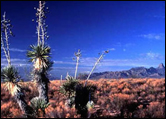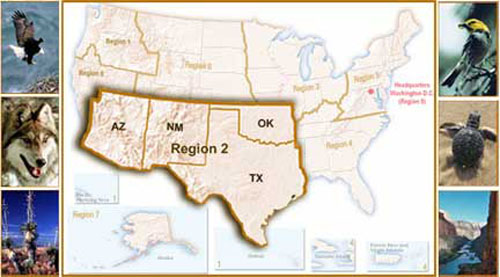Assessment of the Mexican Wolf Program Available for Review
January 9, 2009
The U.S. Fish and Wildlife Service has drafted a Mexican Wolf Conservation Assessment to
broadly address the long-term conservation needs for the Mexican wolf. The assessment is
available for public review and comment until March 10, 2009.
Learn More ...

U.S. Fish & Wildlife Service Investigation Leads to Prosecution in Mexican Wolf Killing
January 2009
The U.S. Fish and Wildlife Service’s (Service) Southwest Region has completed its investigation of a ranch caretaker in southern New Mexico for illegally shooting a Mexican gray wolf.
Service law enforcement special agents presented their investigative findings to the U.S. Attorney’s Office, and the U.S. Attorney’s Office agreed to prosecute the case. The investigation was conducted with assistance from the other state and federal agencies involved in the wolf reintroduction program.
Learn More ...

New Conservation Effort Benefits Rare Species in Southeastern New Mexico
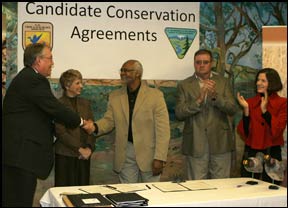 |
| Left to right: Ray Payne (Marbob Oil Company); Linda Rundell (BLM State Director), Benjamin Tuggle (FWS Regional Director), Doug Lynn (Center of Excellence for Hazard Materials Management Executive Director); and Lynn Scarlett, Deputy Secretary for the Department of the Interior.
Photo credit: BLM, Hanson Stuart |
December 2008
Lynn Scarlett, Deputy Secretary for the Department of the Interior, joined the representatives from the U.S. Fish and Wildlife Service (FWS) and the Bureau of Land Management (BLM) at the Rio Grande Nature Center in Albuquerque to kick-off an innovative conservation program that encourages landowners, energy companies and ranchers to voluntarily protect and restore habitat for the lesser prairie chicken and sand dune lizard. Both species are candidates for Endangered Species Act protection.
Learn more
Read the Signed CCA-CCAA

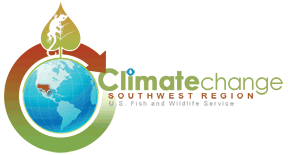 |
| The Southwest Region's logo representative of the region's Climate Change initiatives. |
Climate Change: Simple Changes, Significant Impacts
Fish and Wildlife Service Southwest Region Funds 10 Climate Change Projects
November 2008
Climate change is among the greatest challenges ever faced by conservation community in conserving fish, wildlife, and their habitats. The U.S. Fish and Wildlife Service’s Southwest Region is providing $48,500 as “seed money” to fund 10 employee-initiated climate change project proposals. The projects will be completed within existing agency funds, and address a variety of climate change initiatives including activities aimed at lowering the Service’s carbon footprint, and developing new information to reduce some of the immediate threats to species and habitat based on the best available science.
Read about the 10 Projects
Learn More about the Southwest Region's Efforts to Address Climate Change

Habitat Restoration Project Yields More Pecos Sunflowers
October 2008
The Pecos sunflower is a rare wetland annual plant that grows on wet, alkaline soils at spring seeps, wet meadows and pond margins in New Mexico and Texas. New Mexico State Forestry Division purchased and restored 116 acres near Santa Rosa, New Mexico to protect the rare Pecos sunflower. The Service gave a grant of $75,000 under their Recovery Land Acquisition program and the New Mexico Dept. of Transportation granted the other $75,000 to purchase the cienega. The attached report illustrates with ‘before and after’ photos how a natural area is restored to achieve the desired effect – lots of sunflowers.
"Natural cienega wetlands are very rare and threatened habitats in New Mexico,” said State Forestry Division’s Rare and Endangered Plant Program Manager Bob Sivinski. “A cienega is like an oasis in a desert that provides habitat for many unique native plants and animals. By preserving Blue Hole Cienega, we’re protecting a rare habitat and providing a way to help the Pecos Sunflower recover its population. Our goal is to be able to remove this plant from the endangered and threatened lists.”
Blue Hole Cienega

Wildlife Refuges Severely Impacted by Hurricane Ike:
Some Facilities Completely Lost, Remain Closed to Public
September 2008
The U.S. Fish and Wildlife Service (Service) is reporting that due to impacts caused by Hurricane Ike, four National Wildlife Refuges (Refuge) on the Texas Gulf Coast remain closed to the public. The Texas Chenier Plains Complex, which includes Anahuac, Texas Point, Moody, and McFaddin Refuges, sustained a direct hit from the hurricane and almost total destruction of all facilities.
Until further notice, all public activities on these four refuges are being suspended. This includes public visitation, and all previously scheduled events and hunts.
Read More

Scientists, Land Managers Grapple with Effects of Climate Change on Southwest Wildlife
August 19, 2008
Scientists and land managers will gather in Tucson this week at a climate change workshop. Sponsored by the Southwest and California/Nevada Regions of the U.S. Fish & Wildlife Service, in collaboration with the U.S. Geological Survey’s Western Region, the workshop will address the effects of a changing climate on habitat and wildlife in arid and semiarid ecosystems.
Press Release
What else the Fish and Wildlife Service is Doing to Address Climate Change
A Message from Service Director H. Dale Hall on Climate Change

Please see our National Fish and Wildlife Service Web site for more information on our activities in other areas of the country.
Please take the time to email Lisa Whittle, Southwest Region Web Manager with your comments regarding the Southwest Region website redesign. |
 |

Endangered Socorro Doves Arrive at the Albuquerque Zoo
Species Extinct in the Wild to be Bred for Return to Its Native Island
The Albuquerque Zoo has a new resident! Thanks to the Partners of the Socorro Dove Project the Zoo has received captive-breds Socorro Doves, an important step towards their eventual reintroduction to the wild. Read about it here.

New Mexico Wildlife Refuge Receives National Recognition for Solar and Wind Energy Project
Deputy Secretary of the U.S. Department of the Interior Lynn Scarlett has presented Department of the Interior Environmental Achievement Awards to ten departmental individuals and employees at the department’s Washington headquarters.
“These awards are the equivalent of our Environmental Emmy awards,” said Scarlett. “The ingenuity and dedication of the winners are always inspiring. This year’s winning projects include, just for example, a sustainably designed laboratory, an invention to remove paint from spray cans, a partnership with loggers to remove scrub brush for use in bio-energy production, and a project that puts mustangs to work hauling illegal debris from marijuana gardens on public land."
Interior’s Environmental Achievement Awards recognize employees and partners who have made outstanding contributions through departmental projects in preventing pollution and waste, recycling, green purchasing, environmental management, sustainable designing and the greening of facilities, and using alternative fuel and fuel conservation in transportation.
The San Andres National Wildlife Refuge in southwestern New Mexico was recognized for using a tiered approach to install on-site renewable energy generation, the San Andres National Wildlife Refuge is able to supply 100 percent of its own power for several months out of the year and has decreased energy use by 80 percent from the Fiscal Year 2003 baseline.
Learn More about San Andres National Wildlife Refuge
Learn More about the Southwest Region's Efforts to Address Climate Change
Find a Refuge Near You
Arizona Refuges
New Mexico Refuges
Texas Refuges
Oklahoma Refuges
Refuges thoughout the nation
Endangered Species Bulletin
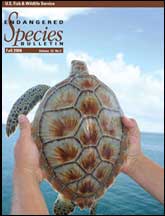
|

